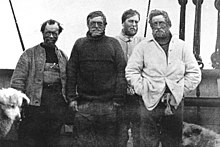Eric Marshall
This article needs additional citations for verification. (April 2018) |
Order of St Stanislaus Mentioned in dispatches |
|---|
Biography

Born in Hampstead, Surrey, on 29 May 1879, he was educated at Monkton Combe School, Bath and at Emmanuel College, Cambridge, before qualifying as a surgeon from St Bartholomew's Hospital. Marshall met Shackleton in 1906 at a house party in London. Shackleton told him about the proposed expedition to the South Pole and suggested Marshall go on a training course on surveying and then he could become the expedition's surgeon, surveyor and cartographer as well as the principal photographer.[1]
According to Leif Mills, who has written about the two men in Polar Friction: the relationship between Marshall and Shackleton, 2012, Marshall was "an indispensable member of Shackleton's expedition; yet on the voyage down from New Zealand to Antarctica, during the long Antarctic winter at their base at Cape Royds and on the actual southern journey, Marshall constantly criticised Shackleton in his diary, sometimes in almost vitriolic language, and seemed to have nothing but contempt for him." Marshall maintained his criticism of Shackleton throughout his life, referring to him as 'the biggest mountebank of the century' in one letter held at the Royal Geographical Society dated 30 August 1956.
Marshall joined the
In autumn 1918, Marshall was posted to Archangel in northern Russia as a member of the
Marshall married Enid in 1922. In the 1930s the family moved to Kenya, where he practised farming for a few years before returning to England. During the
After the War ended, Marshall joined the Ministry of Pensions as a medical officer. When he retired he and his wife moved to Yarmouth in the Isle of Wight. He died on 26 February 1963.
References
- ^ Polar Friction: the relationship between Marshall and Shackleton by Leif Mills, 2012
- ^ "London Gazette, 3 February 1920". Retrieved 2 October 2017.
- ^ Damien Wright. Shackleton's men in the Arctic: polar explorers and Arctic warfare in North Russia 1918-19. Orders & Medals Research Society Journal, September 2017, page 197.
